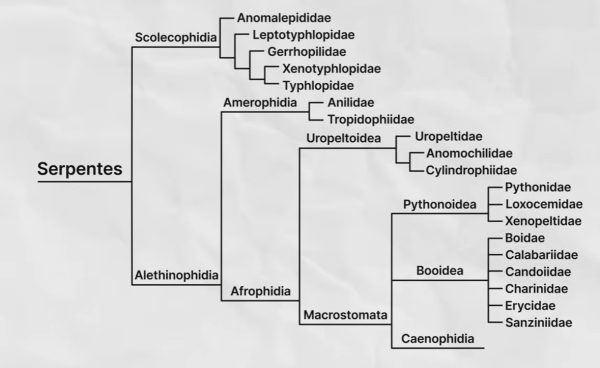Snakes (Serpentes)
This “Snake taxonomy has gotten wild” post from Field Herp Help explains my experience perfectly, the classifications have gotten wild indeed. I remember memorizing 5 families as a kid, that was it (bing bang boom). Now there are 29 with 30 subfamilies?? Insane in the membrane. For the purposes of this site, we will be categorising the species in terms of popularity in the pet trade, given that our priorities are on animal husbandry and not species taxonomy. Below is the a grouping based on FaunaClassifieds' structure which I believe is very effective in helping people find information on the snake in question:
Grouping (CODE):
- Arboreal Boas/Pythons (ABP)
- Ball Pythons (BP)
- Boas (BOA)
- Cornsnakes & Ratsnakes (CR)
- Hognose, Garter, Water & Ribbon Snakes (HGWR)
- Kingsnakes & Milksnakes (KM)
- Pine, Bull, Gopher & Indigo Snakes (PBGI)
- Pythons (PY)
- Rosy, Sand, Ground Boas/Pythons (RSGP)
- Venomous Snakes (VS)
- Other Snakes (OTHER)
If you are really interested in learning about the new classifications and snake taxonomy, I've tried my best to provide an overview below with links to snakes in the respective categories.
Caenophidia
Caenophidia is the infraorder that contains 80% of snake species in the world, including all the Colubrids, Vipers, Elaphids, Slug Snakes, Odd-scaled Snakes, Asian Water Snakes, and Wart Snakes, which are somehow all related to each other. There are seven existing super-families in Caenophidia.
Colubroidea
Colubroidea is the superfamiliy at the center. This is now the “Colubrids”, but there's plenty of arguments over whether numerous groups inside of it, including Natricidae (new world garter/water snakes and old world grass snakes/keelbacks) should be their own separate families.
Colubridae
Colubridae (commonly known as colubrids from Latin: coluber, 'snake') is a family of snakes. With 249 genera, it is the largest snake family. The earliest fossil species of the family date back to the Late Eocene epoch, with earlier origins suspected. Colubrid snakes are found on every continent except Antarctica.
| Common Name | Scientific Name | Other Name(s) |
|---|---|---|
| Thai Bamboo Ratsnake | Oreocryptophis porphyraceus coxi | Red Bamboo Ratsnake, Red Bamboo Snake, Thai Red Mountain Racer, Red Mountain Ratsnake, Black-banded Trinket Snake |
| Western Rat Snake / Black Rat Snake | Pantherophis obsoletus | Pilot Black Snake, Black Snake, “Whoa–that's a huge snake!” |
| Baron's Green Racer | Philodryas baroni | Baron's Racer, Argentine Long-nosed Tree Snake, Baroni Racer |
Elapoidea
Elapoidea is the closest relative to Colubroidea. But the superfamily Elapoidea doesn't just include traditional Elaphids (cobras, kraits, sea snakes, etc.), but also the Lamprophiids (a huge group of ~70 former colubrid genera such as the Sand Snakes, Mock Vipers, and African House Snakes), the Stiletto Snakes, and a few obscure obscure genera that were once thought to be colubrids. In fact, if you want to keep the traditional idea of colubrids as an intact family, then you have to consider elaphids to be just another subfamily of colubrids.
Homalopsidae
Homalopsidae is the next closest relative, the Asian Water Snakes. Note that Elaphids are more closely related to “true” Colubrids than Asian Water Snakes are.
Viperidae
Viperidae is the next most closely related superfamily, consisting of all the traditional Vipers and Pit Vipers
Pareidae
Pareidae, the Slug Snakes, come next. Again, these are former colubrids who turn out to be further from the colubrids than the vipers and elaphids are.
Xenodermidae
Xenodermidae, the Odd-scaled Snakes, are next. These are the weird primitive looking east/southeast Asian snakes like the Dragon Snake.
Acrochordidae
Acrochordidae, the Wart Snakes, round out Caenophidia. Sometimes they are placed outside of Caenophidia altogether.
Booidea
Booidea is the next infraorder, which helpfully contains “almost everything that looks like a boa”, including New World Boas and Anacondas, and the Mexican Dwarf Boas as well as Sand Boas of Asia/Africa and the various “boas” of Madagascar, New Guinea, and Calabar. A couple obscure families of snakes called Bolyeriidae (the Round Island Boas) and Xenophidion (Spinejaw Snakes) may be the closest things to a link between Booidea and Caenphidia and are sometimes placed outside of Booidea.
Pythonoidea
Pythonoidea ends up being completely different from Booidea, and includes not just all the Old World Pythons but also the Mexican Burrowing Python and the Sunbeam Snakes of Southeast Asia.
Uropeltoidea
Uropeltoidea, and not boas, are the closest living relatives to the Pythonoidea. They include the Shieldtail Snakes and the Asian Pipe Snakes, small nondescript burrowing species.
Amerophidia
Amerophidia is a weird superfamily that contains just 3 genera which aren't related to anything else and don't look anything like each other either. They are Anilius (just one species, the False Coral Snake of South America), Trachyboa (the Eyelash Boas of Panama, Columbia, and Ecuador), and Tropidophis (the Caribbean “wood snakes” or “West Indies dwarf boas”).
Scolecophidia
Scolecophidia, the Blind Snakes, end up being the biggest outliers….but there's five different families of blind snakes and they may be more different from each other than, say, a boa is from a viper. Typhlopidae is the main one that everyone knows about, but 40% of blind snakes turn out to be from one of the four families outside of Typhlopidea and may not even be related to Typhlopidea at all but are just the result of convergent evolution.
